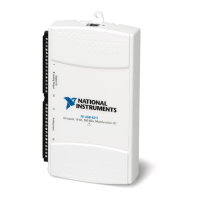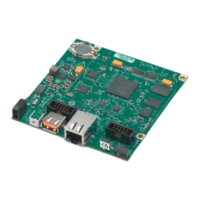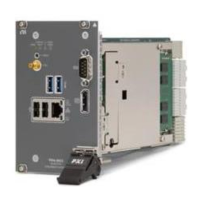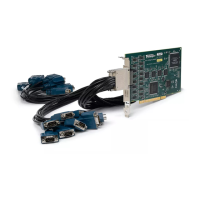© National Instruments | 3-25
NI 6612 User Manual
Other Settings
The counter measures time using the Counter Timebase signal. By default, the counter uses an
onboard 100 MHz signal as the timebase. To change the timebase, use the CI.CtrTimebaseSrc
DAQmx Channel property.
You can filter noise on any PFI signal that is an input to the counter by enabling a filter. Refer
to the PFI Filters section in Chapter 4, PFI, for more information.
If you route the same PFI signal to multiple destinations, you should enable the Synchronization
feature. Refer to Chapter 4,
PFI, for more information.
Quadrature and Two-Pulse Encoder Overview
The NI 6612 can make angular and linear position measurements using quadrature and
two-pulse encoders.
Quadrature Encoders
A quadrature encoder can have up to three channels: channels A, B, and Z. When channel A
leads channel B in a quadrature cycle, the counter increments. When channel B leads channel A
in a quadrature cycle, the counter decrements. The amount of increments and decrements per
cycle depends on the type of encoding: X1, X2, or X4.
• X1 Encoding—Figure 3-27 shows a quadrature cycle and the resulting increments and
decrements for X1 encoding. When channel A leads channel B, the increment occurs on the
rising edge of channel A. When channel B leads channel A, the decrement occurs on the
falling edge of channel A.
Figure 3-27. X1 Encoding
• X2 Encoding—The counter increments or decrements on each edge of channel A,
depending on which channel leads the other. Each cycle results in two increments or
decrements, as shown in Figure 3-28.
Figure 3-28. X2 Encoding
• X4 Encoding—The counter increments or decrements on each edge of channels A and B.
Whether the counter increments or decrements depends on which channel leads the other.
Each cycle results in four increments or decrements, as shown in Figure 3-29.
Ch A
Ch B
Counter Value
7 7 6 5
5
6
Ch A
Ch B
Counter Value
56 8 97 56
8
9 7

